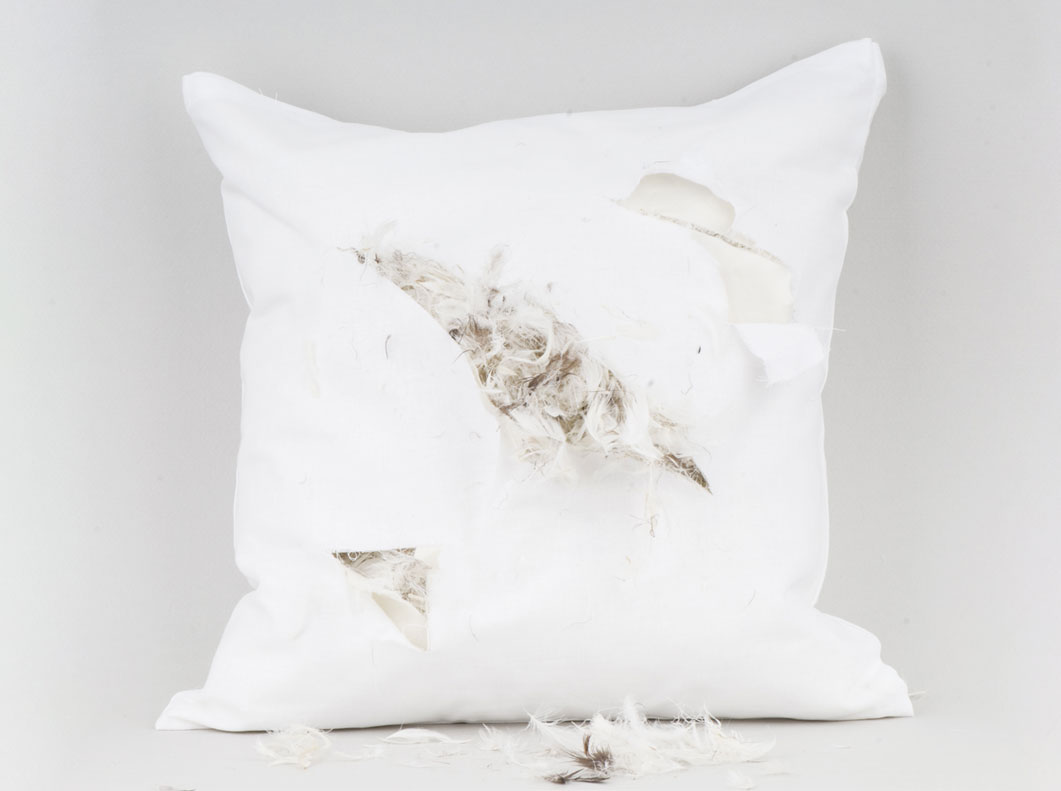A quality down or feather pillow is expensive. These pillows will last for many years, but they will need be washed at least twice a year to keep the feathers clean and fluffy. But feathers can mold if they get wet, and bodily fluids such as sweat and saliva can work their way through the pillowcases and into the feather stuffing. Putting the pillow in the washing machine will help restore the feathers and give you a comfortable night’s sleep knowing your pillow is clean and fresh.

Types of Feather/Down Pillows
Your pillow should have a label that lists the contents inside. “Feather” pillows are made from either goose or duck down, goose or duck feathers, or a combination of the two. Down is the soft, fluffy under-feathers on a bird. Pillows made from down clusters carry the highest price tag, but are softer and last longer. Down is easier to clean than feather/down combinations and less likely to clump and compact. A feather pillow is less expensive, but not as fluffy as down. Duck and goose feathers have a quill attached which can poke through the pillow’s cover.
In the U.S., any clothing or household product that contains down or feathers must be labeled.
An item labeled "100 Percent Down" can be made from only goose or duck down feathers. Products labeled as "Down" can contain a combination of down, feathers, and polyester fill. Any item labeled "Goose Down" must contain at least 90 percent goose down and can contain feathers. The fill rating indicates the amount of down in a product. The higher the number, the better the quality of the item. High-end designer pillows and comforters usually have a rating of 800.>
Examine the Pillow Carefully
Remove the pillow case or cases and examine the pillow material carefully. Look for rips or any stitching that might have come undone. You will need to mend any rips, even small ones, and sew up any seams that might come undone in the washing machine. If you don’t, the agitating action of the washer will make the rip larger and result in a washer full of wet feathers.
Into the Wash
For a top loading washer, it’s best to always wash two pillows to balance the washer. If you don’t have two feather pillows, you can use a polyester or some other kind of pillow. Don’t put a memory foam or latex pillow in a washer. The washer will destroy the foam once it gets wet. Towels can also be used to maintain the balance.
For a front load washer, you can wash one pillow. It’s best to wash the pillow by itself or with some towels because some materials, such as denim, are abrasive and could damage the pillow covering.
Use the gentle cycle of the washer and set the temperature to warm for both the wash and rinse cycles. Add a tiny amount of low-sudsing detergent (1 to 2 teaspoons) or use a half-cup of vinegar and ¼ of a cup of baking soda to whiten and deodorize the pillows. Vinegar has antibacterial qualities which can remove smells from the feathers. Suds and feathers are not a good mix and too much detergent will result in feathers that clump together and make a pillow feel lumpy.
Feel free to run the pillows through an extra rinse cycle to make sure the feathers are squeaky clean.
Into the Dryer
As you remove the pillows from the washer, don’t be concerned by the clumping and lumping. Place the pillow between two towels and gently press down to remove as much moisture as possible.
Fluff the wet pillows as best you can and then put them in the dryer.
If you have wool dryer balls, you can add them to help break up the clumps of feathers. A tennis ball in a sock or even clean canvas sneakers can also be used to help break up the feather clumps.
Set the dryer to low heat and let the pillows spin. Check the pillows every 15 minutes and fluff them by hand to help decrease the drying time. The feather clumps will begin to break up and expand inside the pillow cover. If your pillow was getting a little flat, it should feel plump and soft again. One way to determine if a pillow is completely dry is to press your face into the middle of the pillow. It should feel warm and soft. If it’s cold and damp, run it through the dryer for another 10-15 minutes.
Things to Avoid
Over-drying a feather pillow can make the feathers stiff and brittle. Using too hot of a setting can burn the feathers, which will create a terrible smell and ruin the pillow.

Photo by Artbox on Shutterstock
Letting a wet pillow sit for too long can result in mold which will make the pillow smell horrible. Remove the pillows from the washer as soon as they are done.
A pillow that feels lumpy is the result of unseparated down clusters. Stop the drying cycle every 15 minutes and fluff the pillows by hand to help break up the clumps.
Tips to Extend the Life of Your Feather Pillow
Your pillow should come with a removable protective cover. Place a standard pillowcase over this cover and wash both covers often. It’s easy to forget to wash the protective cover.
Don’t lay on a feather pillow if you have wet hair. Water can make its way into the feathers and cause mold to grow. If a feather pillow gets wet, try to soak up the water or throw it in the dryer on a low heat setting for a few minutes.
To fluff up feather pillows, place them in a dryer on low heat or the air cycle and let them tumble for 10 minutes.
If not using a feather pillow, store it in a pillowcase in a cool, dry space.
A pillow is an important part of getting a good night’s sleep. A pillow that’s too soft or too firm can lead to neck and back pain. If you love your feather pillow, keep it clean and performing at its best by giving it an occasional wash and re-fluff. Your pillow and your body will thank you.

Photo by wavebreakmedia on Shutterstock






















